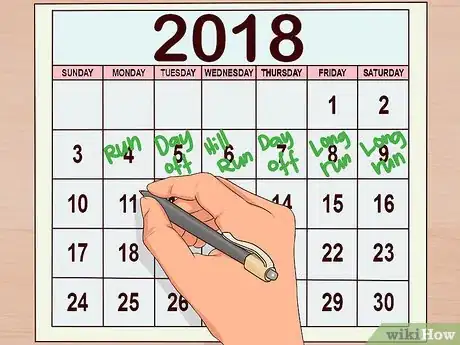This article was co-authored by Tyler Courville. Tyler Courville is a brand ambassador for Salomon Running. He has run in 10 ultra and mountain races across the United States and Nepal, and won the 2018 Crystal Mountain Marathon.
This article has been viewed 27,827 times.
An ultra-marathon is any race that’s longer than a standard marathon, typically between 50 kilometres (31 mi) and 100 kilometres (62 mi), though some races go up to 100 miles (160 km). Some ultra-marathons are based on time, rather than distance: you will have a certain number of hours to cover as much distance as you can. Build up your endurance by running shorter distances multiple days in a row. Prepare for race conditions by running up hills and carrying a pack. Most importantly, train your mind to relax and enjoy the long, steady effort of running an ultra-marathon.
Steps
Training for an Ultra-Marathon
-
1Sign up for the race 3 months in advance. You should give yourself at least 3 months to train, and if you’ve already signed up and paid for the race that’s a great motivator to keep training. Find out about ultra-marathons in your area by searching online or by asking other long-distance runners you know.[1]
-
2Do long runs for 2 days in a row once a week. Doing long runs on back to back days is important so you get used to the feeling of running on tired legs. You can run the whole distance in one day, but this is not a common training strategy. You will build more endurance and strength by breaking up the distance of your race into 2 days of harder effort.[2]
- For example, if your race is 50 miles (80 km), be able to run 25 miles (40 km) one day and another 25 miles (40 km) the next, or 35 miles (56 km) one day and 15 miles (24 km) the next, 2 months before your race.
- Once you can do this, practice it this way for 3 weeks per month until race day, doing a shorter distance one week per month and the week right before race day.
Advertisement -
3Do hill workouts. Become comfortable on hills, because your ultra race will most likely include some hills. Include hills on your regular distance runs. In addition, do some hill-repeat training days, either once a week or every other week alternating with speed workouts.[3]
- Once a week or bi-weekly, run for 1⁄2 mile (0.80 km) up a gradual hill at 90% of your maximum effort, recover in your run back down the hill, and repeat this until you have run for 1 hour.
-
4Do speed interval training to push your threshold higher. Speed training improves your ability to run at your average pace but with a lower heart rate. This makes your normally paced runs feel easier. Speed workouts also help prevent stress injuries, since repeatedly running long distances day after day can cause muscles to overcompensate.[4]
- There are different ways to do speed intervals. One is to do a 40-second sprint with 1-2 minutes of easy running in between, working up to longer intervals gradually. Another is to run at 90% for 1 full minute, with 3 minutes of walking or jogging in between.
- Do speed training sessions for about an hour, once per week or bi-weekly. If you do them bi-weekly, you can alternate them with the days that you do hill workouts.
-
5Give yourself recovery days. Take 2-3 days off per week when training for your ultra-marathon. A sample week could be one or two days of moderate distance runs, a day off, a hill or speed workout day, another day off, then your 2-day long distance runs back to back.[5]
- Doing this will give your body some time to recover between long or hard runs so you do not get injured.
Preparing Fuel and Supplies for Race Day
-
1Figure out fuel that works for you. Since you are practicing long runs during each week of training, you’ll also want to practice fueling during those long runs. Most ultra-runners aim to consume 200-400 calories per hour, eating as often as every 30 minutes.[6]
- You’ll want to start out experimenting with energy gels during your training runs. These are fast-acting high carb gels that are easy to digest.
- Gradually work in other solids like energy bars, bananas, and nuts.
- Stay hydrated. The best rule of thumb is to drink before you are thirsty during long runs.
-
2Pack your bag. The choice and size of your backpack will depend on the length of your race and the expected conditions during the race. Choose a bag that is comfortable to run with and practice running with it during training.[7]
- Some things to include in your bag may be: blister bandages, a mix of fuel (energy gels/bars/chews), electrolyte drink and water, first aid kit, tissues, a map, mobile phone, sunglasses, a lightweight waterproof layer, lightweight gloves, a cap or hat, a head flashlight (if running at night), sunscreen, and a plastic bag for waste, wet clothes or tissues.
- You may also want to bring a lubricant for your feet to help prevent chafing during the race.
-
3Know your aid stations. Look on the race website for information about aid stations. Find out the types of food, drink, and supplies available, and where the stations will be located. This will allow you to figure out what to bring with you on race day and what to leave at home. The less you have to bring, the lighter your pack will be for most of the actual race.[8]
Running the Race
-
1Be confident that you will finish. For your first ultra-marathon, try to eliminate any thoughts that you might not finish or that your time matters. Tell yourself that you’re prepared and that you will finish no matter what. Remember that your first ultra-marathon is a success if you finished, you didn’t get hurt, and you had fun.[9]
-
2Stay calm and hold back in the beginning of the race. It’s common to get a rush of adrenaline right at the beginning of the race. Fight the urge to run faster than you should just because you can. This amount of energy will not last, and will cause you to get extra tired later on.[10]
- Stick to less than the pace that you developed during training, or about 50-65% maximum effort, to be sure that you’re not overdoing it at the start of the race.
-
3Run your own race. Don’t be concerned about other racers. The real race in an ultra-marathon is against yourself. You most likely trained by yourself, so you know what’s best for you during the race too.[11]
-
4Fuel yourself the same way you did during training. A reason that you ran with a pack and supplies during training was so that you could figure out what worked well for you. Don’t change anything, especially regarding fuel, the day of the race.[12]
- Stay hydrated and consume calories as frequently and in the same amount that you did during training.
-
5Stay in the present. Try not to think about the next 30 miles (48 km) that you still have to go. Think about how you feel right then, at that moment, and enjoy it. Enjoy your music if you’ve prepared a playlist for the race. Listen to the sounds of the forest or environment as you run.[13]
- Another technique is to try looking in the near distance to an object and focus on running just to that object. After you pass that object, choose a new one and focus on running to that. This will help keep your mind off the finish and how much total distance you have left to go.
Expert Q&A
-
QuestionWhat do you do as a post running ritual?
 Tyler CourvilleTyler Courville is a brand ambassador for Salomon Running. He has run in 10 ultra and mountain races across the United States and Nepal, and won the 2018 Crystal Mountain Marathon.
Tyler CourvilleTyler Courville is a brand ambassador for Salomon Running. He has run in 10 ultra and mountain races across the United States and Nepal, and won the 2018 Crystal Mountain Marathon.
Professional Runner Create your own ritual! My ritual — well, I always go get a mocha after a big run, because it feels indulgent, and it just gets me in the mentality of rest. I know that if I’ve earned my mocha, I’ve also earned a rest the next day. I think it helps to come up with a ritual that gets you in that mindset.
Create your own ritual! My ritual — well, I always go get a mocha after a big run, because it feels indulgent, and it just gets me in the mentality of rest. I know that if I’ve earned my mocha, I’ve also earned a rest the next day. I think it helps to come up with a ritual that gets you in that mindset. -
QuestionWhat should I eat on a long run?
 Tyler CourvilleTyler Courville is a brand ambassador for Salomon Running. He has run in 10 ultra and mountain races across the United States and Nepal, and won the 2018 Crystal Mountain Marathon.
Tyler CourvilleTyler Courville is a brand ambassador for Salomon Running. He has run in 10 ultra and mountain races across the United States and Nepal, and won the 2018 Crystal Mountain Marathon.
Professional Runner On really big mountain days, I like to bring as much real food as possible. I'm not a big fan of goos, so I run with pizza, and I run with potatoes, and then, of course, I run with PB&J.
On really big mountain days, I like to bring as much real food as possible. I'm not a big fan of goos, so I run with pizza, and I run with potatoes, and then, of course, I run with PB&J.
References
- ↑ https://www.active.com/running/articles/how-to-train-for-your-first-ultra-marathon
- ↑ https://www.washingtonpost.com/graphics/health/ultramarathon/
- ↑ https://www.active.com/running/articles/how-to-train-for-your-first-ultra-marathon
- ↑ https://www.trainingpeaks.com/blog/speedwork-for-ultra-runners/
- ↑ https://www.active.com/running/articles/how-to-train-for-your-first-ultra-marathon
- ↑ http://www.runnersradar.com/nutrition/eat-like-an-elite-runner/
- ↑ https://runnersconnect.net/what-to-bring-in-ultra-bag/
- ↑ https://ultrarunning.com/featured/10-tips-for-running-your-first-ultra-marathon/
- ↑ https://ultrarunning.com/featured/10-tips-for-running-your-first-ultra-marathon/
- ↑ https://ultrarunning.com/featured/10-tips-for-running-your-first-ultra-marathon/
- ↑ https://ultrarunning.com/featured/10-tips-for-running-your-first-ultra-marathon/
- ↑ https://ultrarunning.com/featured/10-tips-for-running-your-first-ultra-marathon/
- ↑ https://ultrarunning.com/featured/10-tips-for-running-your-first-ultra-marathon/















-Step-17-Version-2.webp)


















-Step-17-Version-2.webp)



































